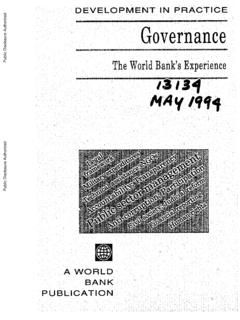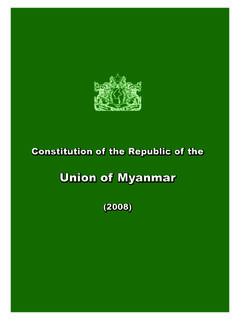Transcription of The Belt and Road Initiative - documents.worldbank.org
1 Public Disclosure Authorized Policy Research Working Paper 8814. Public Disclosure Authorized The Belt and Road Initiative Economic, Poverty and Environmental Impacts Maryla Maliszewska Dominique van der Mensbrugghe Public Disclosure Authorized Public Disclosure Authorized Macroeconomics, Trade and Investment Global Practice April 2019. Policy Research Working Paper 8814. Abstract China's Belt and Road Initiative aims to improve connec- Road Initiative would be largely beneficial. First, global tivity between China and more than 70 countries through income increases by percent (in 2030 relative to the infrastructure investment and regional cooperation.)
2 The baseline). This translates into almost half a trillion dollars in Initiative has the potential to accelerate significantly the 2014 prices and market exchange rates. The Belt and Road rate of economic integration and development in the Initiative area captures 82 percent of the gain, with the region, as trade costs decline. The goals of this paper are largest percent gains in East Asia. Second, globally, the Belt to (i) study the impacts of infrastructure improvements on and Road Initiative could contribute to lifting million Belt and Road Initiative and non Belt and Road Initiative people from extreme poverty and 32 million from mod- countries' trade flows, growth, and poverty; and (ii) suggest erate poverty.
3 Third, the Initiative would lead to a modest policies that would help maximize gains from the Belt and increase in global carbon dioxide emissions, with a complex Road Initiative induced trade cost declines. The analysis set of positive and negative outcomes at the national level captures the trade costs reductions as a result of infrastruc- for other types of emissions. ture improvements. The findings indicate that the Belt and This paper is a product of the Macroeconomics, Trade and Investment Global Practice. It is part of a larger effort by the World Bank to provide open access to its research and make a contribution to development policy discussions around the world.
4 Policy Research Working Papers are also posted on the Web at The authors may be contacted at The Policy Research Working Paper Series disseminates the findings of work in progress to encourage the exchange of ideas about development issues. An objective of the series is to get the findings out quickly, even if the presentations are less than fully polished. The papers carry the names of the authors and should be cited accordingly. The findings, interpretations, and conclusions expressed in this paper are entirely those of the authors. They do not necessarily represent the views of the International Bank for Reconstruction and Development/World Bank and its affiliated organizations, or those of the Executive Directors of the World Bank or the governments they represent.
5 Produced by the Research Support Team The Belt and Road Initiative : Economic, Poverty and Environmental Impacts Maryla Maliszewska 1 and Dominique van der Mensbrugghe 2. JEL: F14, F15, C68, Q56, I32, R41. Keywords: Belt and Road Initiative , Computable General Equilibrium, Poverty, Environment and Trade. 1. Macroeconomics, Trade & Investment, The World Bank Group, 1818 H Street NW, Washington DC 20433. We are grateful to Michele Ruta and Gladys Lopez-Acevedo for comments and suggestions and to Maria Pereira for excellent research assistance. The poverty estimates under section have been provided by Israel Osorio-Rodarte and Rakesh Ramasubbaiah.
6 2. The Center for Global Trade Analysis (GTAP), Department of Agricultural Economics, Purdue University, West Lafayette, IN 47906 Table of contents 1. INTRODUCTION .. 3. 2. BRI-INDUCED TRADE COSTS REDUCTIONS .. 4. 3. MACRO RESULTS .. 7. 4. SOCIAL COSTS/BENEFITS OF THE 9. FACTOR REWARDS, LABOR DISPLACEMENT AND POVERTY IMPLICATIONS .. 9. EMISSIONS IMPLICATIONS .. 11. 5. BRI IMPACTS ON SELECTED COUNTRIES .. 14. 6. IMPACT OF COMPLEMENTARY POLICIES .. 16. 7. SENSITIVITY ANALYSIS .. 18. 8. CONCLUSIONS AND POLICY RECOMMENDATIONS .. 19. TABLES .. 22. ANNEX A: SUMMARY DESCRIPTION OF THE ENVISAGE MODEL AND THE MODEL DIMENSIONS.
7 59. - ii - 1. Introduction The Belt and Road Initiative (BRI) or One Belt One Road (OBOR) Initiative was announced in the Fall of 2013 by President Xi Jinping of the People's Republic of China (PRC). The President invoked the ancient Silk Road announcing the plans to bring Asia, Europe, Africa, and the Middle East closer together by constructing investment and trade networks and creating new institutional linkages. The BRI could promote trade, more efficient resource reallocation and strengthen economic growth across the region. It could also encourage countries to coordinate economic policy and improve regional collaboration.
8 The goals of our analysis are to i) study the impacts of infrastructure improvements on BRI and non-BRI countries' trade flows, growth and poverty; and ii) suggest policies that would help maximize gains from the BRI-induced trade cost declines. To our best knowledge, there are only a few CGE-based studies on the impacts of the BRI. Fan Zhai (2017) uses estimates of elasticity of trade costs with respect to quality of infrastructure and per capita income to estimate the future reductions of trade costs due to BRI. He applies those estimates in a dynamic global CGE model and finds that BRI might bring important benefits to its members and beyond.
9 With moderate assumptions on BRI investment, the simulation results indicate a global welfare gain of of global GDP by 2030 with a boost to global trade by 5%. The vast majority of gains applies to BRI countries. Villafuerte, Corong, and Zhuang (2016). assume that BRI leads to a 25% reduction in road transport margins and 5% in sea transport margins, as well as a significant reduction in time to import by BRI countries due to the accompanying trade facilitation measures. The authors estimate that BRI GDP growth rates could increase by percentage points, while total exports of BRI countries could increase by between $5 billion and $135 billion depending on the assumptions on trade costs reductions.
10 Our analysis adds value to the existing research by incorporating the impacts of BRI-related infrastructure improvements based on bilateral trade time reductions from de Soyres et. al. (2018). In addition, while the CGE analysis provides impacts on several economic variables ( trade, employment, economic growth), we also study the impacts on poverty and greenhouse gas emissions. We also assess the role of trade policy reforms in maximizing the gains from BRI- induced infrastructure improvements. We use the data on value of time from de Soyres et. al. (2018), which is based on Hummels and Schaur (2013) original estimates updated with trade flows from 2014.










